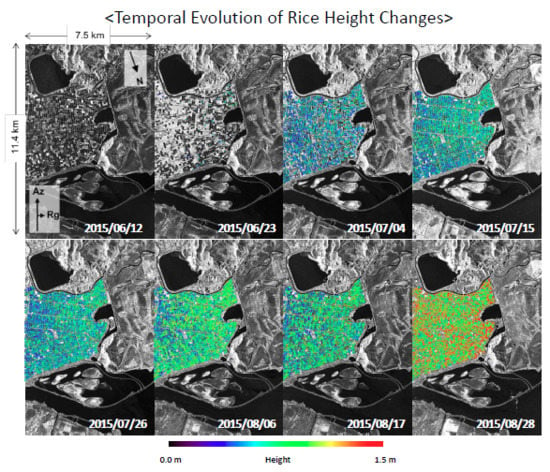Vegetation Height Estimate in Rice Fields Using Single Polarization TanDEM-X Science Phase Data
Abstract
:1. Introduction
2. Data Sets and Test Site
2.1. TDX Data Sets & InSAR Processing
2.2. Test Site and In-Situ Data
3. Methodology
3.1. Single-Pol InSAR Height Inversion Approach
3.2. Ground Phase Estimation on Rice Paddy
3.3. Inversion
4. Results
5. Conclusions
Author Contributions
Funding
Acknowledgments
Conflicts of Interest
References
- Rejesus, R.M.; Mohanty, S.; Balagtas, J.V. Forecasting Global Rice Consumption. 2012. Available online: http://www.agecon.purdue.edu/staff/balagtas/rice_timeseries_v6.pdf (accessed on 20 March 2012).
- FAO. A Regional Rice Strategy for Sustainable Food Security in Asia and the Pacific; FAO: Rome, Italy, 2014; Available online: http://www.fao.org/3/a-i3643e.pdf (accessed on 26 October 2018).
- Cloude, S.R.; Papathanassiou, K.P. Polarimetric SAR interferometry. IEEE Trans. Geosci. Remote Sens. 1998, 36, 1551–1565. [Google Scholar] [CrossRef]
- Cloude, S.R. Dual-baseline coherence tomography. IEEE Geosci. Remote Sens. Lett. 2007, 4, 127–131. [Google Scholar] [CrossRef]
- Cloude, S.R.; Papathanassiou, K.P. Three-stage inversion process for polarimetric SAR interferometry. IEE Proc. Radar Sonar Navig. 2003, 150, 125–134. [Google Scholar] [CrossRef]
- Cloude, S.R. Polarisation: Applications in Remote Sensing; Oxford University Press: Oxford, UK, 2009. [Google Scholar]
- Hajnsek, I.; Kugler, F.; Lee, S.-K.; Papathanassiou, K.P. Tropical-forest-parameter estimation by means of Pol-InSAR: The INDREX-II campaign. IEEE Trans. Geosci. Remote Sens. 2009, 47, 481–493. [Google Scholar] [CrossRef] [Green Version]
- Lee, S.-K.; Kugler, F.; Papathanassiou, K.P.; Hajnsek, I. Quantification of temporal decorrelation effects at L-band for polarimetric SAR interferometry applications. IEEE J. Sel. Top. Appl. Earth Obs. Remote Sens. 2013, 6, 1351–1367. [Google Scholar] [CrossRef]
- Kugler, F.; Lee, S.-K.; Hajnsek, I.; Papathanassiou, K.P. Forest height estimation by means of Pol-InSAR data inversion: The role of the vertical wavenumber. IEEE Trans. Geosci. Remote Sens. 2015, 53, 5294–5311. [Google Scholar] [CrossRef]
- Parks, J.; Kugler, F.; Papathanassiou, P.; Hajnsek, I.; Hallikanien, M. Tree height estimation for boreal forest by means of L and X band PolInSAR and HUTCAT scatterometer. IEEE Geosci. Remote Sens. Lett. 2007, 4, 466–470. [Google Scholar] [CrossRef]
- Lavalle, M.; Simard, M.; Hensly, S. A temporal decorrelation model for polarimetric radar interferometry. IEEE Trans. Geosci. Remote Sens. 2012, 50, 2880–2888. [Google Scholar] [CrossRef]
- Simard, M.; Denbina, M. An assessment of temporal decorrelation compensation methods for forest canopy height estimation using airborne L-band same-day repeat-pass polarimetric SAR interferometry. IEEE J. Sel. Top. Appl. Earth Obs. Remote Sens. 2018, 11, 95–111. [Google Scholar] [CrossRef]
- Kugler, F.; Schulze, D.; Hajnsek, I.; Pretzsch, H.; Papathanassiou, K.P. TanDEM-X Pol-InSAR performance for forest height estimation. IEEE Trans. Geosci. Remote Sens. 2014, 52, 6404–6422. [Google Scholar] [CrossRef]
- Lee, S.-K.; Kugler, F.; Papathanassiou, K.; Hajnsek, I. Multibaseline polarimetric SAR interferometry forest height inversion approaches. In Proceedings of the 5th International Workshop POLinSAR, Frascati, Italy, 24–28 January 2011. [Google Scholar]
- Lee, S.-K.; Fatoyinbo, T.E.; Lagomasino, D.; Feliciano, E.; Trettin, C. Multibaseline TanDEM-X Mangrove Height Estimation: The Selection of the Vertical Wavenumber. IEEE J. Sel. Top. Appl. Earth Obs. Remote Sens. 2018, 8, 3608–3618. [Google Scholar] [CrossRef]
- Krieger, G.; Moreira, A.; Fiedler, H.; Hajnsek, I.; Werner, M.; Younis, M.; Zink, M. TanDEM-X: A satellite formation for high-resolution SAR interferometry. IEEE Trans. Geosci. Remote Sens. 2007, 45, 3317–3341. [Google Scholar] [CrossRef] [Green Version]
- Zink, M.; Bachmann, M.; Bräutigam, B.; Fritz, T.; Hajnsek, I.; Moreira, A.; Wessel, B.; Krieger, G. TanDEM-X: The new global DEM takes shape. IEEE J. Mag. 2014, 2, 8–23. [Google Scholar] [CrossRef]
- Zink, M.; Backmann, M.; Braeutigam, B.; Fritz, T.; Hajnsek, I.; Krieger, G.; Wessel, B. TanDEM-X Mission Status: The Complete Topography of the Earth. In Proceedings of the 2016 IEEE International Geoscience and Remote Sensing Symposium, Beijing, China, 10–15 July 2016; pp. 317–320. [Google Scholar]
- TanDEM-X Ground Segment DEM Products Specification Document. TD-GS-PS-0021. 2016. Available online: https://tandemx-science.dlr.de/ (accessed on 5 August 2016).
- Lee, S.-K.; Fatoyinbo, T.E. TanDEM-X Pol-InSAR inversion for mangrove canopy height estimation. IEEE J. Sel. Top. Appl. Earth Obs. Remote Sens. 2015, 8, 3608–3618. [Google Scholar] [CrossRef]
- Sadeghi, Y.; St-Onge, B.; Leblon, B.; Simard, M. Canopy height model (CHM) derived from a TanDEM-X InSAR DSM and an airborne lidar DTM in boreal forest. IEEE J. Sel. Top. Appl. Earth Obs. Remote Sens. 2016, 9, 381–397. [Google Scholar] [CrossRef]
- Soja, M.J.; Askne, J.I.H.; Ulander, L.M.H. Estimation of boreal forest properties from TanDEM-X data using inversion of the interferometric water cloud model. IEEE Geosci. Remote Sens. Lett. 2017, 14, 997–1001. [Google Scholar] [CrossRef]
- Soja, M.J.; Persson, H.J.; Ulander, L.M.H. Estimation of forest biomass from two-level model inversion of single-pass InSAR data. IEEE Geosci. Remote Sens. Lett. 2015, 53, 5083–5099. [Google Scholar] [CrossRef]
- Treuhaft, R.; Goncalves, F.; dos Santos, J.R.; Keller, M.; Palace, M.; Madsen, S.N.; Sullivan, F.; De Alencastro Graça, P. Tropical-forest biomass estimation at X-band from the spaceborne TanDEM-X interferometer. IEEE Geosci. Remote Sens. Lett. 2015, 12, 239–243. [Google Scholar] [CrossRef]
- Rossi, C.; Erten, E. Paddy-rice monitoring using TanDEM-X. IEEE Trans. Geosci. Remote Sens. 2015, 53, 900–910. [Google Scholar] [CrossRef]
- Hajnsek, I.; Busche, T. TanDEM-X: Science activities. In Proceedings of the 2015 IEEE International Geoscience and Remote Sensing Symposium, Milan, Italy, 26–31 July 2015; pp. 2892–2894. [Google Scholar]
- Announcement of Opportunity: TanDEM-X Science Phase, TD-PD-PL-0032. 2014. Available online: https://tandemx-science.dlr.de/ (accessed on 19 May 2014).
- Erten, E.; Lopez-Sanchez, J.M.; Yuzugullu, O.; Hajnsek, I. Retrieval of agricultural crop height from space: A comparison of SAR techniques. Remote Sens. Environ. 2016, 187, 130–144. [Google Scholar] [CrossRef] [Green Version]
- Lopez-Sanchez, J.M.; Vicente-Guijalba, F.; Erten, E.; Campos-Taberner, M.; Garcia-Haro, F.J. Retrieval of vegetation height in rice fields using polarimetric SAR interferometry with TanDEM-X. Remote Sens. Environ. 2017, 192, 33–44. [Google Scholar] [CrossRef]
- Yuzugullu, O.; Erten, E.; Hajnsek, I. Assessment of Paddy Rice Height: Sequential Inversion of Coherent and Incoherent Models. IEEE J. Sel. Top. Appl. Earth Obs. Remote Sens. 2018, 11, 3001–3013. [Google Scholar] [CrossRef]
- TerraSAR-X Basic Product Specification, TX-GS-DD-3302. 2009. Available online: http://sss.terrasar-x.dlr.de/ (accessed on 26 October 2018).
- Yoon, S.Y.; Lee, S.-K.; Won, J.-S. Rice Paddy Height Estimation from Single-polarization TanDEM-X Science Phase Data. In Proceedings of the 2017 IEEE International Geoscience and Remote Sensing Symposium, Fort Worth, TX, USA, 23–28 July 2017; pp. 930–933. [Google Scholar]
- TanDEM-X Payload Ground Segment: CoSSC Generation and Interferometric Consideration. TP-PGS-TN-3129. 2012. Available online: https://tandemx-science.dlr.de/ (accessed on 15 May 2012).
- Gatelli, F.; Monti Guarnieri, A.; Parizzi, F.; Pasquali, P.; Prati, C.; Rocca, F. The wavenumber shift in SAR interferometry. IEEE Trans. Geosci. Remote Sens. 1994, 32, 855–864. [Google Scholar] [CrossRef]
- Lee, S.-K.; Ryu, J.-H. High-accuracy tidal flat digital elevation model construction using TanDEM-X Science Phase data. IEEE J. Sel. Top. Appl. Earth Obs. Remote Sens. 2017, 10, 2713–2724. [Google Scholar] [CrossRef]
- Statistics Korea, Agricultural Area Investigation. 2015. Available online: http://meta.narastat.kr/metasvc/svc/SvcMetaDcDtaPopup.do?orgId=101&confmNo=114033&kosisYn=Y (accessed on 26 October 2018).
- Yuzugullu, O.; Erten, E.; Hajnsek, I. Rice growth monitoring by means of X-band co-polar SAR: Feature clustering and BBCH scale. IEEE Geosci. Remote Sens. Lett. 2015, 12, 1218–1222. [Google Scholar] [CrossRef]
- Ballester-Berman, J.D.; Lopez-Sanchez, J.M. Combination of direct and double-bounce ground responses in the homogeneous oriented volume over ground model. IEEE Geosci Remote Sens. Lett. 2011, 8, 54–58. [Google Scholar] [CrossRef]
- Ballester-Berman, J.D.; Lopez-Sanchez, J.M.; Fortuny-Guasch, J. Retrieval of biophysical parameters of agricultural crops using polarimetric SAR interferometry. IEEE Trans. Geosci. Remote Sens. 2005, 43, 683–694. [Google Scholar] [CrossRef] [Green Version]
- Erten, E.; Rossi, C.; Yuzugullu, O. Polarization impact in TanDEM-X data over vertical-oriented vegetation: The paddy-rice case study. IEEE Geosci. Remote Sens. Lett. 2015, 12, 1501–1505. [Google Scholar] [CrossRef]
- Lopez-Sanchez, J.M.; Ballester-Berman, J.D.; Hajnsek, I. First results of rice monitoring practices in Spain by means of time series of TerraSAR-X dual-pol images. IEEE J. Sel. Top. Appl. Earth Obs. Remote Sens. 2011, 4, 412–422. [Google Scholar] [CrossRef]
- Lopez-Sanchez, J.M.; Ballester-Berman, J.D.; Marquez-Moreno, Y. Model limitations and parameter estimation methods for agricultural applications of polarimetric SAR interferometry. IEEE Trans. Geosci. Remote Sens. 2007, 45, 3481–3493. [Google Scholar] [CrossRef]
- Lopez-Sanchez, J.M.; Cloude, S.R.; Ballester-Berman, J.D. Rice phenology monitoring by means of SAR polarimetry at X-band. IEEE Trans. Geosci. Remote Sens. 2012, 50, 2695–2709. [Google Scholar] [CrossRef]
- Lopez-Sanchez, J.M.; Vicente-Guijalba, F.; Ballester-Berman, J.D.; Cloude, S.R. Influence of incidence angle on the coherent copolar polarimetric response of rice at X-band. IEEE Geosci. Remote Sens. Lett. 2015, 12, 249–253. [Google Scholar] [CrossRef]
- Kim, S.-W.; Hong, S.-H.; Won, J.-S. An Application of L-band Synthetic Aperture Radar to Tide height Measurement. IEEE Trans. Geosci. Remote Sens. 2005, 43, 1472–1478. [Google Scholar]
- Lee, S.-K.; Hong, S.-H.; Kim, S.-W.; Yamaguchi, Y.; Won, J.-S. Polarimetric Features of Oyster Farm Observed by AIRSAR and JERS-1. IEEE Trans. Geosci. Remote Sens. 2005, 44, 2728–2735. [Google Scholar] [CrossRef]
- Radiometric Calibration of TerraSAR-X Data: Beta Naught and Sigma Naught Coefficient Calculation; INFOTERRA: Friedrichshafen, Germany, 2008.
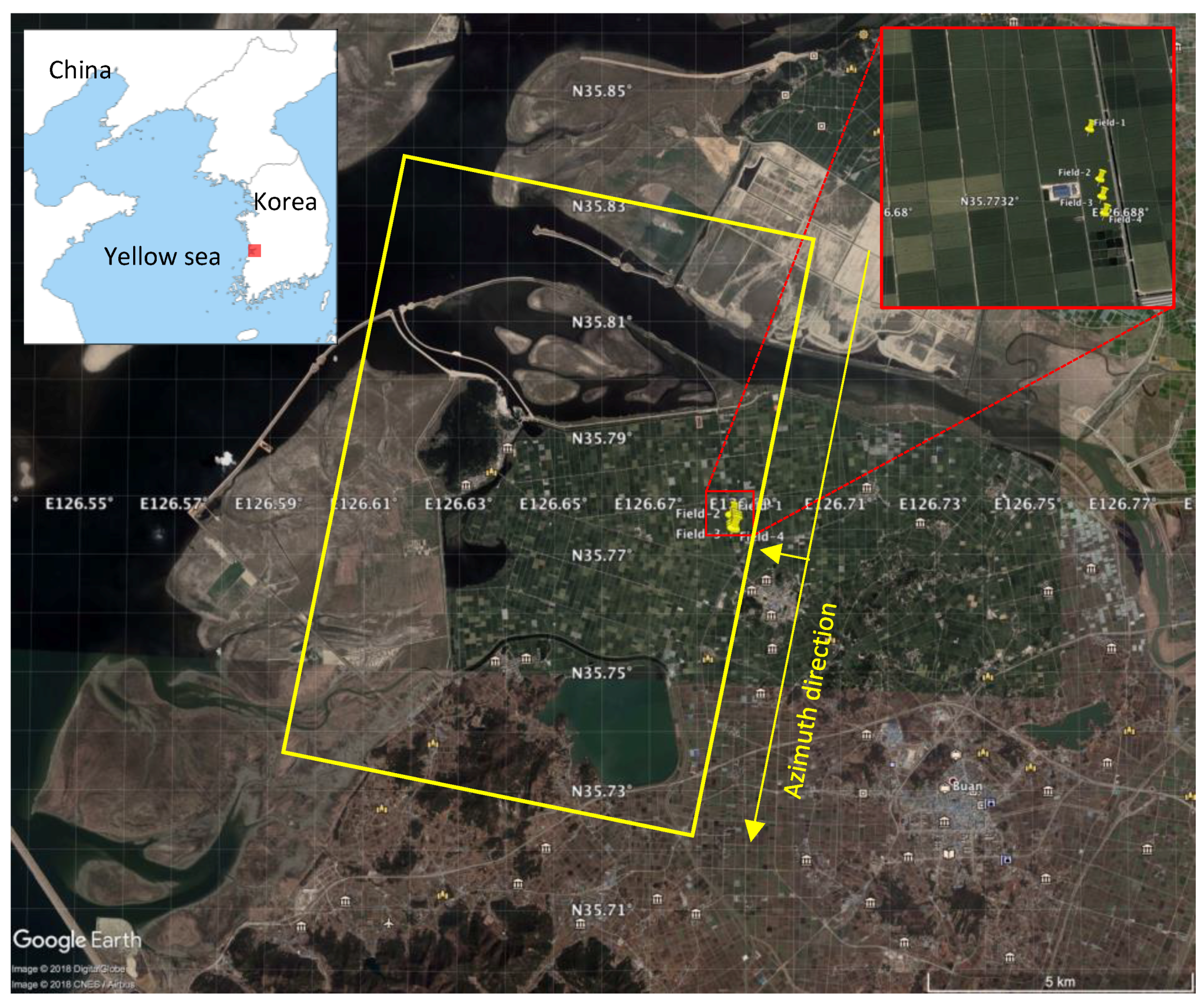
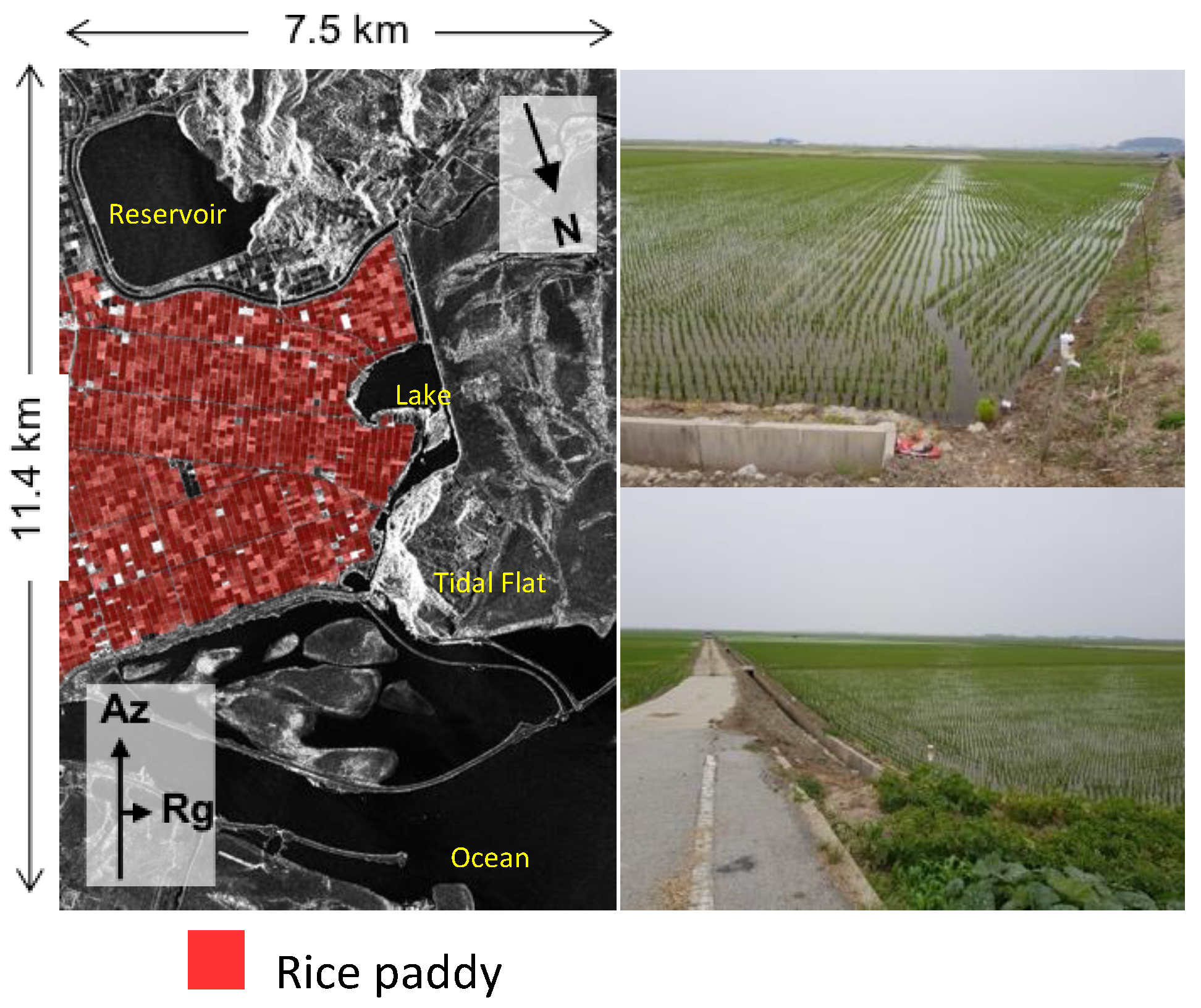

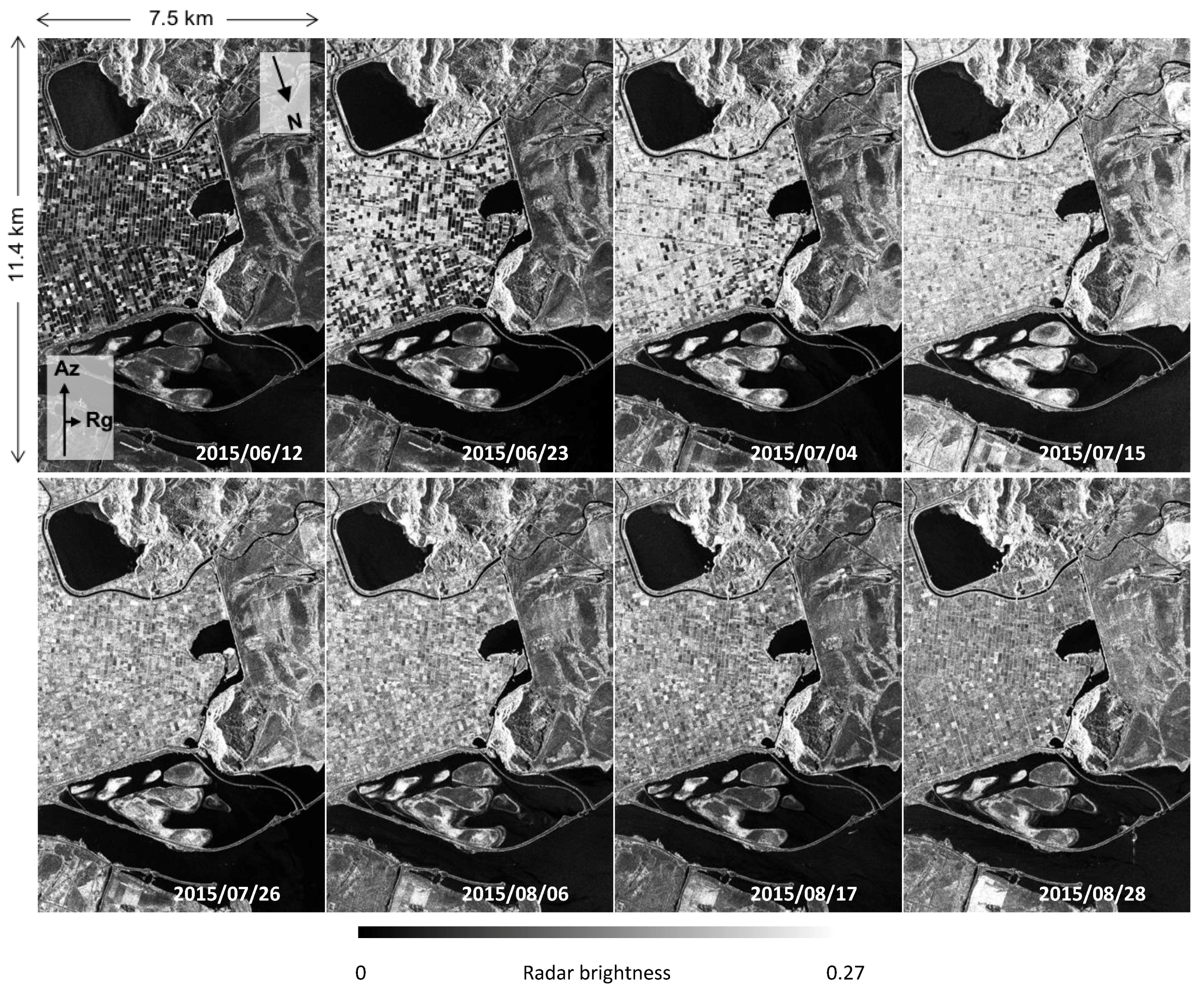
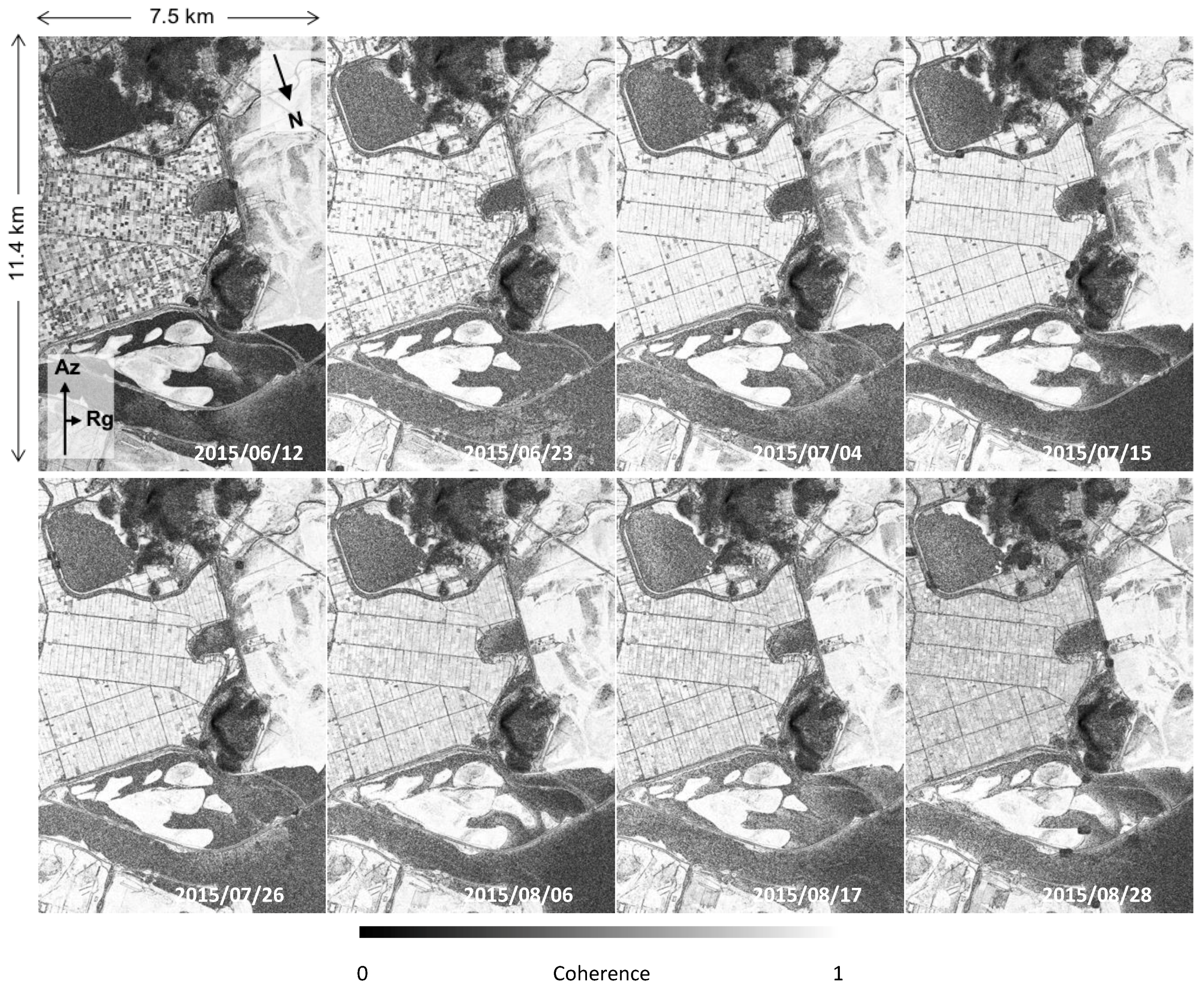
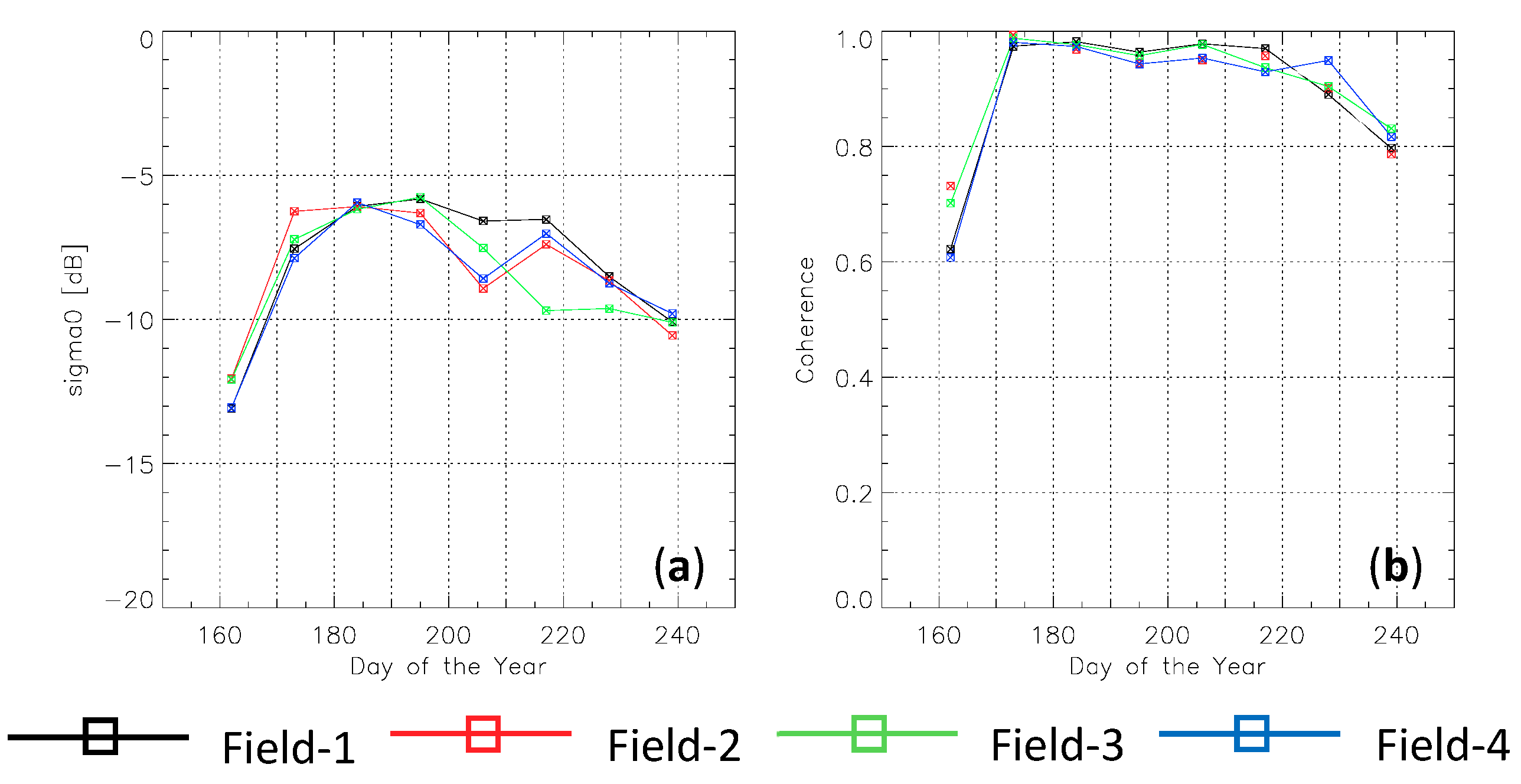


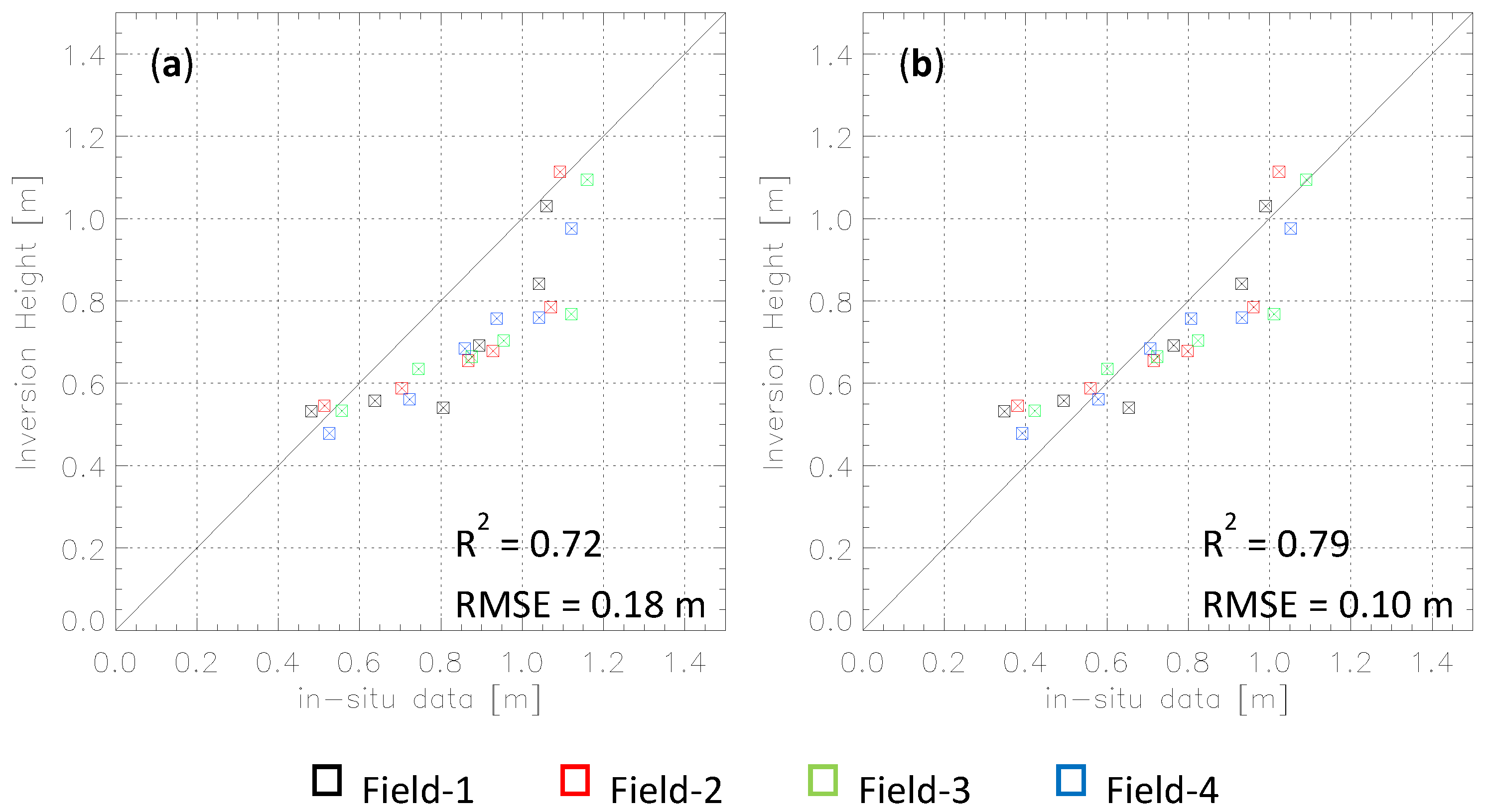
| Date (yyyy/mm/dd) | DoY 1 [days] | Incidence Angle [Deg.] | Polarization | kz [Rad/m] | Height of Ambiguity [m] |
|---|---|---|---|---|---|
| 2015/06/12 | 162 | 28.98 | HH | −2.00 | −3.14 |
| 2015/06/23 | 173 | 28.98 | HH | −2.00 | −3.14 |
| 2015/07/04 | 184 | 28.98 | HH | −2.00 | −3.14 |
| 2015/07/15 | 195 | 28.98 | HH | −2.00 | −3.14 |
| 2015/07/26 | 206 | 28.98 | HH | −2.00 | −3.14 |
| 2015/08/06 | 217 | 28.98 | HH | −2.00 | −3.14 |
| 2015/08/17 | 228 | 28.98 | HH | −2.00 | −3.14 |
| 2015/08/28 | 239 | 28.98 | HH | −2.00 | −3.14 |
| Date (yyyy/mm/dd) | DoY 1 [days] | Field-1 [m] | Field-2 [m] | Field-3 [m] | Field-4 [m] |
|---|---|---|---|---|---|
| 2015/05/29 | 148 | 18.9 | 16.9 | 18.4 | 16.2 |
| 2015/06/09 | 159 | 25.5 | 24.1 | 23.7 | 27.5 |
| 2015/06/24 | 174 | 42.0 | 41.4 | 38.9 | 35.2 |
| 2015/07/10 | 190 | 51.8 | 57.3 | 65.6 | 62.9 |
| 2015/07/20 | 200 | 75.7 | 83.4 | 83.3 | 81.6 |
| 2015/08/06 | 217 | 89.4 | 92.8 | 95.4 | 93.7 |
| 2015/08/20 | 231 | 108.1 | 110.9 | 116.6 | 107.0 |
| 2015/09/04 | 246 | 104.1 | 107.9 | 115.4 | 116.6 |
| 2015/09/19 | 261 | 108.6 | 110.5 | 118.8 | 112.0 |
| 2015/10/06 | 278 | 105.1 | 106.3 | 116.4 | 109.0 |
© 2018 by the authors. Licensee MDPI, Basel, Switzerland. This article is an open access article distributed under the terms and conditions of the Creative Commons Attribution (CC BY) license (http://creativecommons.org/licenses/by/4.0/).
Share and Cite
Lee, S.-K.; Yoon, S.Y.; Won, J.-S. Vegetation Height Estimate in Rice Fields Using Single Polarization TanDEM-X Science Phase Data. Remote Sens. 2018, 10, 1702. https://doi.org/10.3390/rs10111702
Lee S-K, Yoon SY, Won J-S. Vegetation Height Estimate in Rice Fields Using Single Polarization TanDEM-X Science Phase Data. Remote Sensing. 2018; 10(11):1702. https://doi.org/10.3390/rs10111702
Chicago/Turabian StyleLee, Seung-Kuk, Sun Yong Yoon, and Joong-Sun Won. 2018. "Vegetation Height Estimate in Rice Fields Using Single Polarization TanDEM-X Science Phase Data" Remote Sensing 10, no. 11: 1702. https://doi.org/10.3390/rs10111702




